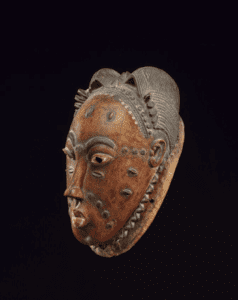At its core, medium specificity in art is the belief that each art form has its own unique capabilities.
It’s the idea that a painting, for instance, can express something a sculpture can’t, and vice versa.
We’ll jump into the nuances of this concept, exploring how artists leverage the strengths of their chosen mediums to create impactful works.
Understanding medium specificity helps us appreciate the distinctiveness of each art piece and the intention behind its creation.
Explaining Medium Specificity
Medium specificity dives into the heart of what makes each art form distinct from another.
As art history enthusiasts, we’re excited by how artists channel the intrinsic properties of their selected mediums to communicate messages that perhaps couldn’t be as powerful in another form.
Take film for example, a medium we’re intimately familiar with at filmmaking lifestyle.
What elevates it above other art forms is its ability to synthesize movement, performance, visual art, and sound.
Consider the immersive experience of Citizen Kane – the film’s groundbreaking use of deep focus and storytelling largely relies on the capabilities unique to cinema.
On the flip side, when we look at painting, we find a different type of engagement.
A piece like Starry Night by Vincent van Gogh offers a tactile texture and a vibrancy of colors that only the medium of paint can produce.
Key aspects that make painting special include:
- The physicality of the brush strokes,
- Unique color mixing possibilities,
- The influence of light on the artwork’s presence.
Each medium informs the artist’s approach to structure and form, which in turn affects our interaction with the work.
Understanding medium specificity is like having a lens that brings the nuances of each piece into sharper clarity.
This insight allows us to not just see but truly perceive the intention woven into the fabric of the artwork.
Photography has its own set of exclusive capabilities that differ from film/video, Even though both sharing the power of the visual image.
The way a single moment is captured in a photo, the framing, the lighting, can evoke an intensity of emotion in stasis that a moving image often disperses over time.

It is the stillness within the frame that often tells a louder story, arresting time in a single, definitive statement.
As we explore the depths of medium specificity further, it stands out that this principle does more than define the limits of an art form; it unleashes the artist’s potential to innovate within those boundaries.
This creates a fertile ground for artistic exploration, where the limitations of each medium can actually inspire creative breakthroughs.
The Importance Of Medium Specificity In Art
Grasping the concept of medium specificity is crucial when delving into the world of art.
It acts as a guiding principle that shapes our understanding and appreciation of different art forms.
Emphasizing certain features intrinsic to a medium allows artists to explore and express ideas in ways that best suit the medium’s strengths.
Medium specificity carries weight in distinguishing the experience one has with an artwork.
A painting can envelop us in texture and color, whereas a film engulfs us in narrative and visual movement.
Here are some key reasons why medium specificity holds such importance:
- Recognition of Strengths – Each art form has inherent qualities that lend themselves to different types of storytelling and expression.
- Innovation Within Boundaries – Artists often push the limits of their medium, leading to creative breakthroughs.
- Guided Interpretation – Medium specificity helps provide context and directs our analytical gaze when engaging with a work of art.
When we analyze great film directors like Stanley Kubrick or Alfred Hitchcock, we notice their mastery over the medium of film.
Their works, like 2001: A Space Odyssey and Psycho, respectively, are not simply stories told through moving images; they are experiences crafted through the capabilities and limitations inherent to filmmaking.
These directors’ acute awareness of medium specificity allows them to manipulate framing, pacing, and sound to create an immersive experience that is uniquely cinematic.
Likewise, in the realm of painting, artists like Jackson Pollock or Mark Rothko took the pillars of their medium – canvas, color, and brushstrokes – and orchestrated their works in such a way that the materiality of the paint and the canvas’s space became the primary focus.
In doing so, they emphasize the medium’s specific characteristics to produce something only achievable within the constraints of painting itself.
Our engagement with art is enhanced by our understanding of medium specificity.
It’s this principle that defines an art piece’s approach and addresses the why behind an artist’s chosen method of representation.
Intuitively, we may sense this congruence between content and form, even if we’re not explicitly aware of medium specificity as a concept.
Historical Development Of Medium Specificity
The concept of medium specificity has evolved significantly over time.
In the late 18th and early 19th centuries, aesthetic theories began to recognize that each artistic medium had its own particular strengths.
It was during this period that the
By the mid-20th century, modernist critics like Clement Greenberg pushed the idea further, arguing for the purity of the arts.
He championed the idea that each medium should seek to perfect its own unique capabilities.
This purist approach informed works like Jackson Pollock’s Autumn Rhythm and films such as Orson Welles’s Citizen Kane, both leveraging their respective formats to offer experiences not replicable in other mediums.

The 1960s conceptual art movement brought a critical inquiry into the aesthetics of different art forms:
- Challenging the traditional confines of art,
- Encouraging the intermingling of mediums,
- Fostering a new dialogue About the role and influence of the medium in the message.
This period also witnessed the emergence of hybrid forms of art where, for instance, video art tested the boundaries between filmmaking and fine art inspired by the likes of Nam June Paik’s Global Groove.
The transition into the digital age further blurred these lines, as multimedia works became more prevalent and accessible.
Our understanding and engagement with medium specificity also influence how we approach filmmaking today.
Digital effects revolutionize traditional storytelling and the use of sound design manipulates audiences’ emotions, crafting layers of meaning within the film’s narrative structure.
Every technical choice we make in the creation of a film—whether it’s the use of a particular lens or editing technique—holds the potential to shape the viewer’s experience in subtle yet profound ways.
Examples Of Medium Specificity In Different Art Forms
In painting, medium specificity comes to the fore through texture and brushwork.
The Starry Night by Vincent van Gogh encapsulates this, with its swirling skies created through thick impasto strokes.
These tactile methodologies cannot be replicated in digital mediums, reinforcing the uniqueness of painting as a form of expression.
Sculpture, on the other hand, engages space and form in a manner distinct from two-dimensional art.
David by Michelangelo demonstrates the medium’s specificity – the life-sized marble statue conveys a sense of permanence and solidity that is inherent to the sculptural form.
In the world of literature, the narrative voice and the use of literary devices are exclusive to the medium of writing.
Novels such as To Kill a Mockingbird by Harper Lee Use first-person narrative to provide an intimate connection between the reader and the character’s perspective, which differs greatly from visual storytelling.
We turn to film, where medium specificity is exemplified by the use of:
- camera movement,
- Editing techniques,
- Lighting,
- Special effects.
For example, 2001: A Space Odyssey showcases the medium’s capacity for visual storytelling through Stanley Kubrick’s innovative use of special effects, which creates an immersive experience unique to film.
In music, the specificity lies in the auditory experience and the artist’s manipulation of sound and silence.
The Rite of Spring by Igor Stravinsky challenged traditional musical structures, utilizing rhythm to evoke emotions in a way that cannot be translated into other art forms.
With the advent of digital art, new possibilities have arisen.
Video games like The Last of Us Part II demonstrate the interactivity that is exclusive to digital media.
The player’s active role in navigating the narrative and the immersive graphic environments highlight medium specificity in the digital age.
Understanding the distinct characteristics of various art forms enhances our appreciation and informs our critical analyses.
Each medium possesses strengths and limitations, and it’s through these parameters that artists express their creativity and conceive works that resonate deeply with audiences.
Medium Specificity As A Tool For Artists’ Intentions
Medium specificity isn’t just a theoretical concept; it’s a vital tool that artists employ to convey their intentions with precision and power.
By harnessing the intrinsic qualities of their chosen mediums, artists can express complex ideas and emotions in ways that words alone cannot capture.
A sculptor might exploit the three-dimensional form to explore space and movement, as in Alexander Calder’s kinetic sculptures, while a filmmaker could use close – up shots to reveal intimate details of a character’s inner world, a technique often seen in the works of Ingmar Bergman.
Utilizing medium specificity allows artists to provide a guided experience for their audience.
This deliberate manipulation of medium can –
- Highlight certain aspects of a narrative or conceptual framework,
- Engage the senses in a way that deepens the interaction with the work,
- Create a unique, immersive atmosphere that’s inextricable from the artist’s message.
Take for example the cinematic masterpiece Blade Runner, where director Ridley Scott uses the visual language of film noir blended with science fiction to craft a dystopian world that’s rich with meaning and mood.
Every frame serves to plunge the viewer deeper into the narrative, proving that the right choice and use of a medium is fundamental in achieving a work’s intended impact.
The power of employing medium specificity rests not just in representing reality but also in shaping it.
Artists like Frida Kahlo used the medium of painting to turn personal pain into potent visual stories.

Her raw depictions create a profound personal connection with the audience, transforming individual experience into a shared one.
This capacity to resonate on such an emotional level is what makes medium specificity an indispensable aspect of the creative process for both artists and viewers alike.
What Is Medium Specificity In Art – Wrap Up
We’ve seen how medium specificity is a cornerstone of artistic expression shaping how we interpret and value art.
It’s a lens through which the unique properties of each art form are not only recognized but celebrated.
As artists master their mediums, they guide us through narratives and concepts with an unmatched level of immersion and emotional engagement.
The digital age might have blurred the lines but it’s also opened up new avenues for creativity where the principles of medium specificity still hold true.
By embracing these principles, artists continue to push boundaries and invite us into experiences that are as diverse as the mediums themselves.
Our journey through the arts is richer for it and our understanding of what it means to create is continually deepened by the power of medium specificity.
Frequently Asked Questions
What Is Medium Specificity In Art?
Medium specificity refers to the inherent strengths and unique capabilities of different art forms.
It’s the concept that each artistic medium should be appreciated and understood based on what it can do best.
Why Is Medium Specificity Important?
Medium specificity is important as it shapes our understanding and appreciation of art.
Recognizing each medium’s unique capabilities leads to innovation within its boundaries and guides in interpreting the artwork.
How Did Modernist Critics View Medium Specificity?
Modernist critics like Clement Greenberg emphasized the purity of the arts, advocating for focusing on perfecting each medium’s unique capabilities and avoiding the blending of different artistic mediums.
What Impact Did The 1960s Conceptual Art Movement Have On Medium Specificity?
The 1960s conceptual art movement challenged medium specificity by encouraging the intermingling of mediums and pushing the boundaries of traditional art forms.
How Does Medium Specificity Influence Filmmaking Today?
In filmmaking, medium specificity is demonstrated through the strategic use of digital effects and sound design, which enhance the storytelling and contribute to a unique viewer experience.
Can You Give An Example Of Medium Specificity In Sculpture?
Medium specificity in sculpture might involve the artist exploiting characteristics such as texture, form, and space to engage the viewer in a way that’s unique to three-dimensional artwork.
How Does Understanding Medium Specificity Affect The Appreciation Of Art?
Understanding the distinctive qualities of each art form enhances critical analysis and appreciation.
It allows audiences to engage with the artwork at a deeper level, recognizing the artist’s intention and the medium’s unique influence.
Why Do Artists Utilize Medium Specificity?
Artists use medium specificity to convey their intentions with precision and power, express complex ideas, and create an immersive atmosphere integral to their message.


